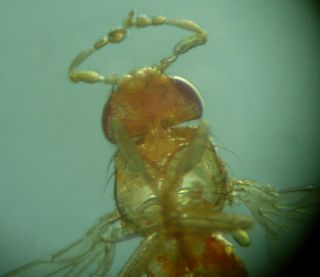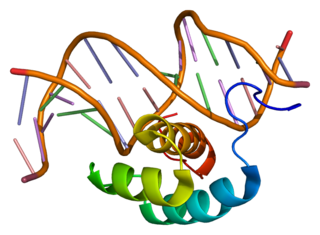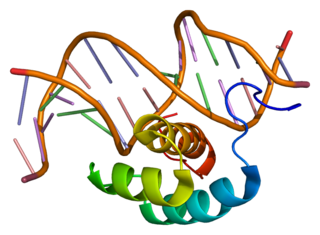Related Research Articles

A homeobox is a DNA sequence, around 180 base pairs long, found within genes that are involved in the regulation of patterns of anatomical development (morphogenesis) in animals, fungi, plants, and numerous single cell eukaryotes. Homeobox genes encode homeodomain protein products that are transcription factors sharing a characteristic protein fold structure that binds DNA to regulate expression of target genes. Homeodomain proteins regulate gene expression and cell differentiation during early embryonic development, thus mutations in homeobox genes can cause developmental disorders.
The ParaHox gene cluster is an array of homeobox genes from the Gsx, Xlox (Pdx) and Cdx gene families.
Hox genes, a subset of homeobox genes, are a group of related genes that specify regions of the body plan of an embryo along the head-tail axis of animals. Hox proteins encode and specify the characteristics of 'position', ensuring that the correct structures form in the correct places of the body. For example, Hox genes in insects specify which appendages form on a segment, and Hox genes in vertebrates specify the types and shape of vertebrae that will form. In segmented animals, Hox proteins thus confer segmental or positional identity, but do not form the actual segments themselves.

Antennapedia is a Hox gene first discovered in Drosophila which controls the formation of legs during development. Loss-of-function mutations in the regulatory region of this gene result in the development of the second leg pair into ectopic antennae. By contrast gain-of-function alleles convert antennae into ectopic legs.

PDX1, also known as insulin promoter factor 1, is a transcription factor in the ParaHox gene cluster. In vertebrates, Pdx1 is necessary for pancreatic development, including β-cell maturation, and duodenal differentiation. In humans this protein is encoded by the PDX1 gene, which was formerly known as IPF1. The gene was originally identified in the clawed frog Xenopus laevis and is present widely across the evolutionary diversity of bilaterian animals, although it has been lost in evolution in arthropods and nematodes. Despite the gene name being Pdx1, there is no Pdx2 gene in most animals; single-copy Pdx1 orthologs have been identified in all mammals. Coelacanth and cartilaginous fish are, so far, the only vertebrates shown to have two Pdx genes, Pdx1 and Pdx2.

Homeobox protein Hox-B7 is a protein that in humans is encoded by the HOXB7 gene.

Homeobox protein Hox-A10 is a protein that in humans is encoded by the HOXA10 gene.

Homeobox protein Hox-A1 is a protein that in humans is encoded by the HOXA1 gene.

Homeobox protein Hox-A11 is a protein that in humans is encoded by the HOXA11 gene.

Homeobox protein Hox-B5 is a protein that in humans is encoded by the HOXB5 gene.

Homeobox protein Hox-C8 is a protein that in humans is encoded by the HOXC8 gene.

Homeobox protein Hox-D13 is a protein that in humans is encoded by the HOXD13 gene. This gene belongs to the homeobox family of genes. The homeobox genes encode a highly conserved family of transcription factors that play an important role in morphogenesis in all multicellular organisms.

Homeobox protein Hox-A7 is a protein that in humans is encoded by the HOXA7 gene.

Homeobox protein Hox-B9 is a protein that in humans is encoded by the HOXB9 gene.

Homeobox protein Hox-C6 is a protein that in humans is encoded by the HOXC6 gene. Hox-C6 expression is highest in the fallopian tube and ovary. HoxC6 has been highly expressed in many types of cancers including prostate, breast, and esophageal squamous cell cancer.

Homeobox protein Hox-A3 is a protein that in humans is encoded by the HOXA3 gene.

Homeobox protein Hox-C13 is a protein that in humans is encoded by the HOXC13 gene.

Homeobox protein Hox-C9 is a protein that in humans is encoded by the HOXC9 gene.
The Cdx gene family, also called caudal genes, are a group of genes found in many animal genomes. Cdx genes contain a homeobox DNA sequence and code for proteins that act as transcription factors. The gene after which the gene family is named is the caudal or cad gene of the fruitfly Drosophila melanogaster. The human genome has three Cdx genes, called CDX1, CDX2 and CDX4. The zebrafish has no cdx2 gene, but two copies of cdx1 and one copy of cdx4. The Cdx gene in the nematode Caenorhabditis elegans is called pal-1.
Robb Krumlauf is an American developmental biologist. He is best known for researching the Hox family of transcription factors. He is most interested in understanding the role of the Hox genes in the hindbrain and their role in areas of animal development, such as craniofacial development. Krumlauf worked with a variety of renowned scientists in the field of developmental biology throughout his time researching Hox genes.
References
- ↑ Cornell, RA; Ohlen, TV (2000). "VND/NKX, ind/GSH, and MSH/MSX: Conserved regulators of dorsoventral neural patterning?". Curr. Opin. Neurobiol. 10 (1): 63–71. doi:10.1016/S0959-4388(99)00049-5. PMID 10679430. S2CID 30021040.
- ↑ Pei, Z; Wang, B; Chen, G; Nagao, M; Nakafuku, M; Campbell, K (Jan 25, 2011). "Homeobox genes Gsx1 and Gsx2 differentially regulate telencephalic progenitor maturation". Proceedings of the National Academy of Sciences of the United States of America. 108 (4): 1675–80. Bibcode:2011PNAS..108.1675P. doi: 10.1073/pnas.1008824108 . PMC 3029701 . PMID 21205889.
- ↑ Brooke; et al. (1998). "The ParaHox gene cluster is an evolutionary sister of the Hox gene cluster". Nature. 392 (6679): 920–922. Bibcode:1998Natur.392..920B. doi:10.1038/31933. PMID 9582071. S2CID 4398740.